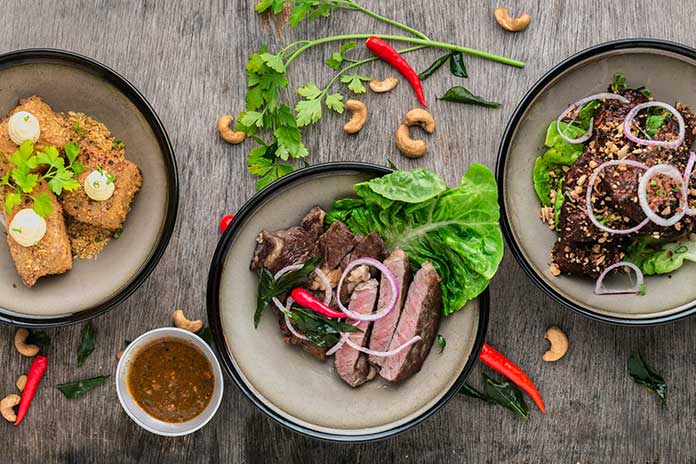Since the reduced fat content in food leaves more calories for carbohydrates and protein, Low Fat supports weight loss as follows:
Due to the high-calorie density of fat, the amount consumed increases when replacing it with protein and carbohydrates.
Those who replace the extra calories with reduced fat consumption, primarily with carbohydrates from salad, high-fiber vegetables and whole grains, benefit from more food volume – both on the plate and in the stomach—an essential aspect regarding saturation.
The saturation is additionally supported by increasing the protein content of the food.
Attention: Losing weight only works if calories are saved. To successfully lose weight with the “Low Fat 30” diet, not only should the nutrient ratio be changed – i.e. less fat in favor of protein and carbohydrates – but the total calorie content of the food should be reduced at the same time.
If the energy content of the food remains the same, energy consumption must be increased through more physical activity in the context of weight reduction. However, a sensible change in diet or diet should always be combined with sufficient exercise.
Table of Contents
What Foods Are Allowed?
If you focus on a low-fat diet, there is enough scope to eat various foods. Regular consumption of vegetables, salad, fruit, whole grain products and legumes is recommended so that the diet is not only low in fat but also wholesome and nutritious. Even pasta, which rings the alarm bell for low-carb fans, is no problem.
In addition, there are numerous low-fat alternatives to high-fat foods, such as full-fat dairy products or fried foods.
Since “Low Fat 30” doesn’t prohibit anything, there’s still nothing to be said against occasionally enjoying small amounts of high-fat treats.
An Overview Of Suitable Foods As Part Of A Low-Fat Diet
- Vegetable salad
- Potatoes & fruit
- Whole grain products (e.g. bread or oatmeal)
- Low-fat dairy products (e.g. low-fat quark)
- pseudo-grain*
- Low-fat cheese (e.g. Harzer)
- Small amounts of nuts, kernels, seeds & almonds
- Lean meat & fish
- Small amounts of high-quality vegetable oils
- Legumes
- Small amounts of avocado, fatty sea fish & olives
Also Read: How Much Should You Sleep Per Night To Lose Weight?
Preparation Tips For The Low-Fat Kitchen
When it comes to low-fat, fat-saving cooking methods are also important. Instead of frying or frying food in a lot of fat, low-calorie and nutrient-saving cooking methods such as steaming or steaming are preferred. Coated frying pans and small amounts of olive or rapeseed oil are suitable for searing. For low-fat grilling, mushrooms, vegetables, meat or fish can be brushed with oil.
Instead of spreading butter or margarine thickly on the bread, a pinch of spreadable fat is enough for the taste – if desired in combination with tomato paste or mustard. With cream cheese, camembert and co., spreadable fats can be wholly dispensed with. Due to the healthy fatty acids, guacamole or almond butter can be spread a little more liberally on the bread.
Which Foods Are Taboo?
There are no bans, but high-fat foods should be avoided – taking into account the 30 percent rule. Animal fat should be avoided, mainly favoring small amounts of high-quality vegetable oils, nuts or olives.
The Most Essential “Low Fat 30” Rules
To quickly implement a diet à la “Low Fat 30”, people who want to lose weight must follow three rules.
- Food may consist of a maximum of 30 percent fat.
- It is only eaten when hungry.
- As soon as a feeling of satiety occurs, the meal ends.
The Correct Calculation Of The Fat Percentage
The total number of calories consumed must consist of no more than 30 percent fat. If you don’t want to plan the whole day, you have to ensure that the respective dishes or foods do not contain more than 30 percent fat. This means that meals can be put together more or less spontaneously – assuming a certain willingness to do arithmetic.
The calculation is comparatively simple and is based on the calorie content of one gram of fat. One gram of fat is equivalent to around nine calories.
For example, if you eat a food that contains 100 calories and 8 grams of fat, the result is 8 X 9 kcal = 72 calories of fat. In terms of energy percentages, this corresponds to 72 per cent (72 out of 100 kilocalories). In this case, that would be far too high a fat content for “Low Fat 30”.
Tip: Anyone who frequently cooks dishes with numerous ingredients of unknown fat content and has to do a lot of calculations will benefit from unique fat tables.
Also Read: Avoid These Foods To Lose Belly Fat!


